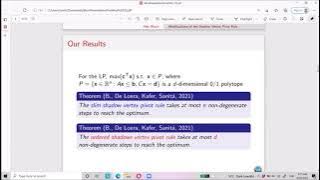Polyhedral combinatorics | Disproved conjectures | Linear programming | Conjectures
Hirsch conjecture
In mathematical programming and polyhedral combinatorics, the Hirsch conjecture is the statement that the edge-vertex graph of an n-facet polytope in d-dimensional Euclidean space has diameter no more than n − d. That is, any two vertices of the polytope must be connected to each other by a path of length at most n − d. The conjecture was first put forth in a letter by to George B. Dantzig in 1957 and was motivated by the analysis of the simplex method in linear programming, as the diameter of a polytope provides a lower bound on the number of steps needed by the simplex method. The conjecture is now known to be false in general. The Hirsch conjecture was proven for d < 4 and for various special cases, while the best known upper bounds on the diameter are only sub-exponential in n and d. After more than fifty years, a counter-example was announced in May 2010 by Francisco Santos Leal, from the University of Cantabria. The result was presented at the conference 100 Years in Seattle: the mathematics of Klee and Grünbaum and appeared in Annals of Mathematics. Specifically, the paper presented a 43-dimensional polytope of 86 facets with a diameter of more than 43. The counterexample has no direct consequences for the analysis of the simplex method, as it does not rule out the possibility of a larger but still linear or polynomial number of steps. Various equivalent formulations of the problem had been given, such as the d-step conjecture, which states that the diameter of any 2d-facet polytope in d-dimensional Euclidean space is no more than d; Santos Leal's counterexample also disproves this conjecture. (Wikipedia).




















